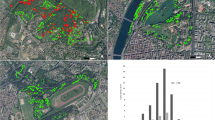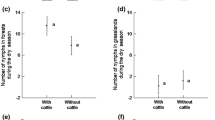Abstract
This study evaluates the impact of cattle-raising on ticks associated with wildlife in the Pantanal region of Brazil, by trapping free-living ticks using a CO2 tick trap. The traps were equally distributed in two areas: a 600-ha protected area (PA) and the Nhumirim Ranch (NR). Both areas are contiguous and located at the sub-region of Nhecolândia (18°59′S; 56°39′W), Pantanal, Brazil. In each area, four habitat types were selected: cerrado (tropical savanna), forest patches, lakes and soda lakes. The last two are temporary lagoons of fresh and salted water, respectively. A total of 980 nymphs, 613 adults and 13 larvae of ticks Amblyomma were collected in 256 h of collection. In a pen of calves infested by Ornithodoros rostratus 114 specimens were collected, including larvae, nymphs and adults. Adults of A. cajennense and A. parvum were more abundant in the savanna at NR, but not differed among habitat types at PA. There was a tendency of having more nymphs in NR than in PA. The higher number of ticks found in the NR in comparison to the PA is not due to the presence of cattle itself but probably due to introduced dogs and horses, habitat alteration.




Similar content being viewed by others
References
Alho CJR, Lacher TE (1991) Mammalian conservation in the Pantanal of Brazil. In: Mares MA, Schmidly DJ (eds) Latin American Mammalogy: Topics in History, Biodiversity, and Conservation. Univ. of Oklahoma Press, Norman, OK, pp 280–294
Barros ATM, Pellegrin AO (2002) Manejo produtivo. In: Embrapa Pantanal (Org) Sistema de produção de gado de corte no Pantanal, vol 1. Embrapa Pantanal, Corumbá, MS, pp 41–45
Barros-Battesti DM, Arzua M, Bechara GH (2006) Carrapatos de importância médico-veterinária da região neotropical: um guia ilustrado para identificação de espécies. Vox/ICTTD-3/Butantan, São Paulo
Bengins RG, Kock RA, Fischer J (2002) Infectious animal diseases: the wildlife/ livestock interface. Rev Sci Tech OIE 21:53–65
Billings AN, Yu X, Teel PD, Walker DH (1998) Detection of Spotted Fever Group Rickettsia in Amblyomma cajennense (Acari:Ixodidae) in South Texas. J Med Entomol 35:474–478
Butler JF, Holscher KH, Adeyeye O, Gibbs EPJ (1984) Sampling techniques for burrow dwelling ticks in reference to potential African swine fever virus vectors. In: Griffiths DA, Bowman CE (ed) Acarology. VI. Ellis Horwood, Chichester, 2:165–174
Chacón SC, Correia PG, Barbieri FS, Daemon E, Faccini JLH (2003) Efeito de três temperaturas constantes sobre a fase não parasitária de Amblyomma cajennense (Fabricius, 1787) (Acari: Ixodidae). Rev Bras Parasitol Vet 12:13–20
Combes C (2001) Parasitism: the ecology and evolution of intimate interactions. The University of Chicago Press, London
Cork A, Park KC (1996) Identification of electrophysiologically-active compounds for the malaria mosquito, Anopheles gambiae, in human sweat extracts. Med Vet Entomol 10:269–276
Daszak P, Cunningham AA, Hyatt AD (2000) Emerging infectious diseases of wildlife—threats to biodiversity and human health. Science 288:319–320
Dias E, Martins AV (1939) Spotted fever in Brazil: a summary. Am J Trop Hyg 1:103–108
Donatelli RJ (2004) Birds and dynamic habitat mosaics in the Pantanal. In: Pantanal conservation research initiative, Annual Report Earthwatch Institute
DUBS B (1992) Birds of southwestern Brazil. catalogue and guide to the birds of the Pantanal of Mato Grosso and its border areas. Küsnacht, Bretona, p 164
Dumler JS, Bakken JS (1995) Ehrlichial diseases of humans: emerging tick-borne infections. Clin Infect Dis 20(5):1102–1110
Eaton D, Donatelli RJ (2005) Cattle associated impacts on aquatic macroinvertebrate and wading birds assemblages of rare, highly productive saline (soda lake) habitats in the Nhecolândia region of the Pantanal. In: Abstracts From Frontiers In Tropical Biology Atbc 2005 (Association For Tropical Biology And Conservation); Universidade Federal de Uberlandia, Brazil
Estrada-Pena A, Jongejan F (1999) Ticks feeding on humans: a review of records on human-biting Ixodoidea with special reference to pathogen transmission. Exp Appl Acarol 23:685–715
Garcia R (1962) Carbon dioxide as an attractant for certain ticks (Acarina: Argasidae and Ixodidae). Ann Entomol Soc Am 55:605–606
Garcia R (1965) Collection of Dermacentor andersoni (Stiles) with carbon dioxide and its application in studies of Colorado tick fever virus. Am J Trop Med Hyg 14:1090–1093
Ginsberg H, Ewing C (1989) Habitat distribution of Ixodes dammini (Acari: Ixodidae) and Lyme disease spirochetes on Fire Island, New York. J Med Entomol 26:183–189
Gray JS (1985) A carbon dioxide trap for prolonged sampling of Ixodes ricinus L. populations. Exp Appl Acarol 1:35–44
Guedes E, Leite RC, Prata MCA, Pacheco RC, Walker DH, Labruna MB (2005) Detection of Rickettsia rickettsii in the tick Amblyomma cajennense in a new Brazilian spotted fever-endemic area in the state of Minas Gerais. Mem Inst Oswaldo Cruz 100:841–845
Guglielmone AA, Moorhouse DE, Wolf G (1985) Attraction to carbon dioxide of unfed stages of Amblyomma triguttatum triguttatum Koch, under field conditions. Acarologia 26:123–129
Holsher KH, Gearhart HL, Barker RW (1980) Electrophysiological responses of three tick species to carbon dioxide in the laboratory and field. Ann Entomol Soc Am 73:288–292
Hulbert SH (1984) Pseudoreplication and the design of ecological field experiments. Ecol Monogr 54:187–211
Ito FH, Vasconcellos SA, Bernardi F, Nascimento AA, Labruna MB, Arantes IG (1984) Evidência sorológica de Brucelose e leptospirose e parasitismo por Ixodideos em animais silvestres do Pantanal Sul-Mato-Grossense. Ars Vet 14:302–310
Koch HG, Macnew RW (1981) Comparative catches of field populations of lone star ticks by CO2 emitting dry-ice, dry-chemical and animal-baited devices. Ann Entomol Soc Am 74:498–500
Labruna MB, Jorge RSP, Sana DA, Jacomo ATA, Kashivakura CK, Furtado MM, Ferro C, Perez SA, Silveira L, Santos TS, Marques SR, Morato RG, Nava A, Adania CH, Teixeira RHF, Gomes AAB, Conforti VA, Azevedo FCC, Prada CS, Silva JCR, Batista AF, Marvulo MFV, Morato RLG, Alho CJR, Pinter A, Ferreira PM, Ferreira F, Battesti DMB (2005) Ticks (Acari: Ixodida) on wild carnivores in Brazil. Exp Appl Acarol 36:149–163
Lemos AM, Teodoro RL, Oliveira GP, Madalena FE (1985) Comparative performance of six Holstein–Friesian x Guzerá grades in Brazil. 3 Burdens of Boophilus microplus under field conditions. Anim Prod 41(2):187–191
Machado RZ, Machado CR, Toledo CZP, Ferreira FA, Rocha UF (1985) Ecologia em carrapatos XIII–Boophilus microplus (canestrini, 1887) em infestações naturais de veados (Ozotocerus bezoarticus bezoarticus, Linaeus, 1766) e capivaras (Hydrochoerus hydrochoris hydrochoeris, Linaeus, 1762) dos estados de São Paulo e Matogrosso do Sul. ARS Veterinaria 1(1):47–50
Martins JR, Medri IM, Oliveira CM, Guglielmone A (2004) Ocorrência de carrapatos em Tamanduá-Bandeira (Myrmecophaga tridactyla) e Tamanduá-mirim (Tamanduá-Tetradactyla) na região do Pantanal Sul-Mato-Grossense, Brasil. Ciência Rural 34(1):293–295
Mourão GM, Oliveira, MD, Calheiros DF, Padovani CR, Marques JR, Uetanabaro M (2002) O Pantanal Mato-grossense In: Os sites e o programa brasileiro de pesquisas ecológicas de longa duração, Seedliger U, Cordazzo C, Barbosa F (ed), Belo Horizonte: CNPq.
Mumcuoglu KY, Frish K, Sarov B, Nanor E, Gross E, Gat Z, Galum R (1993) Ecological studies on the brown dog tick Rhipicephalus sanguineus (Acari; Ixodidae) in southern Israel and its relationship to spotted fever group Rickettsiae. J Med Entomol 30:114–121
Norval RAI, Yunker CE, Butler JF (1987) Field sampling of unfed adults of Amblyomma hebraeum Koch. Exp Appl Acarol 3:213–217
Norval RAI, Yunker CE, Gibson JD, Deem SLD (1988) Field sampling of unfed nymphs of Amblyomma hebraeum. Exp Appl Acarol 4:173–177
Oliveira PR, Borges LMF, Lopes CML, Leite RC (2000) Population dynamics of the free-living stages of Amblyomma cajennense (Fabricius, 1787) (Acari:Ixodidae) on pastures of Pedro Leopoldo, Minas Gerais, Brazil. Vet Parasitol 92:295–301
Pereira MC, Szabó MPJ, Bechara GH, Matushima EK, Duarte JMB, Rechav Y, Fielden L, Keirans J (2000) Ticks (Acari:Ixodidae) associated with wild animals in the Pantanal Region of Brazil. J Med Entomol 37:979–983
Randolph SE (2000) Tick and tick-borne disease systems in space and from space. Adv Parasitol 47:217–243
Sampaio IBM (2002) Estatística aplicada à experimentação animal. Fundação de Estudo e Pesquisa em Medicina Veterinária e Zootecnia (ed), 2rd edn. Belo Horizonte
Sartor IF, Faccini JLH, Kuchembuck MRG, Curi PR (1992) Estudo da resistência de ao carrapato Boophilus microplus (Canestrini)(Acari) em bovinos das raças gir, holandesa e mestiços 1/2 gir/holandês. Vet Zootec 4:25–33
Sonenshine DE (1993) Biology of ticks. Oxford, New York. 471p
Walker DH (1998) Tick-transmitted infectious diseases in the United States. Annu Rev Public Health 19:237–269
Wambura PN, Gwakisa PS, Silayo RS, Rugaimukamu A (1998) Breed-associated resistance to tick infestations in Bos indicus and their crosses with Bos taurus. Vet Parasitol 77(1):63–70
Wang E, Ferreira VL, Himmelstein J (2004) Amphibians and Reptiles of the Southern Pantanal. In: Pantanal conservation research initiative, Annual Report 2004. Earthwatch Institute, p. 34–44
Williams ES, Yuill T, Artois M, Fisher J, Haigh SA (2002) Emerging infectious disease in wildlife. Rev Sci Tech OIE 21:139–157
Williams RC, Ritchie SA, Russell RC, Eiras AE, Kline DL, Geier M (2006) Geographic variation in attraction to human odor compounds by Aedes aegypti mosquitos (Diptera: Culicidae): a laboratory study. J Chem Ecol 32:1625–1634
Acknowledgements
This study was supported by Conselho Nacional de Pesquisa e Desenvolvimento (CNPq) and Coordenação de Aperfeiçoamento de Pessoal de Nível Superior (CAPES). We thank ‘EMBRAPA Pantanal’ for logistic support. The experiments in this work comply with the current laws of Brazil.
Author information
Authors and Affiliations
Corresponding author
Rights and permissions
About this article
Cite this article
Cançado, P.H.D., Piranda, E.M., Mourão, G.M. et al. Spatial distribution and impact of cattle-raising on ticks in the Pantanal region of Brazil by using the CO2 tick trap. Parasitol Res 103, 371–377 (2008). https://doi.org/10.1007/s00436-008-0982-8
Received:
Accepted:
Published:
Issue Date:
DOI: https://doi.org/10.1007/s00436-008-0982-8




